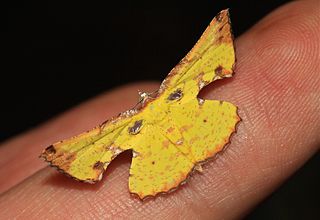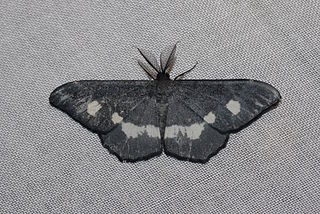
Chiretolpis is a genus of moths in the family Erebidae.
Gampola is a genus of moths in the family Arctiidae. They were found from Sri Lanka, where the generic name is due to the Gampola area of Kandy, where the first species was discovered. In June 2016, another species was found from India and other few nearby countries such as China, Hong Kong, and Thailand.
Migoplastis is a genus of moths in the subfamily Arctiinae first described by Rudolf Felder in 1868. They are confined to India's Nilgiri Mountains and to Sri Lanka.
Padenia is a genus of moths in the subfamily Arctiinae described by Frederic Moore in 1882.
Mesolia is a genus of moths of the family Crambidae described by Émile Louis Ragonot in 1889.
Ramila is a genus of moths of the family Crambidae.
Niaccaba is a monotypic moth genus of the family Noctuidae first described by Francis Walker in 1866. Its single species, Niaccaba sumptualis, described by the same author one year earlier, is found in Sri Lanka, the Ryukyu Islands and Borneo.

Perina is a genus of tussock moths in the family Erebidae. It was described by Francis Walker in 1855 and is found in China, Sri Lanka and throughout India.

Amblychia is a genus of moths in the family Geometridae described by Achille Guenée in 1857.

Corymica is a genus of moths in the family Geometridae described by Francis Walker in 1860.

Hyperythra is a genus of moths in the family Geometridae. It was erected by Achille Guenée in 1857.

Hypochrosis is a genus of moths in the family Geometridae. It was erected by Achille Guenée in 1857.

Hyposidra is a genus of moths in the family Geometridae first described by Achille Guenée in 1857.
Nadagara is a genus of moths in the family Geometridae first described by Francis Walker in 1861.
Platycerota is a genus of moths in the family Geometridae.

Thinopteryx is a genus of moths in the family Geometridae erected by Arthur Gardiner Butler in 1883.

Timandra is a genus of moths in the family Geometridae first described by Philogène Auguste Joseph Duponchel in 1829.

Zeheba is a genus of moths in the family Geometridae described by Frederic Moore in 1887.
Aquita acontioides is an Asian member of the family Nolidae.

Cacyparis is a genus of moths in the family Nolidae erected by Francis Walker in 1863. It is found in throughout India, Sri Lanka, Myanmar, Papua New Guinea and Australia.










